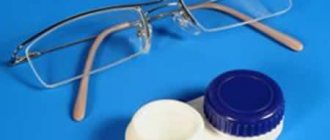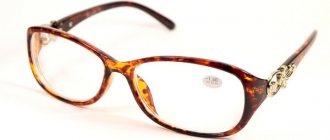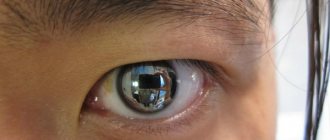Lenses in glasses intended for vision correction have different optical properties. When you visit an ophthalmologist or optometrist, he or she will conduct an examination and determine the options that are right for you. These data are indicated in the recipe. And if you start using glasses with lenses made according to a different prescription, then:
- they will not effectively correct your vision;
- you will experience discomfort.
Sign up for a free glasses selection
But lenses differ not only in optical properties. There are other characteristics you should be aware of. Which glasses lenses are best to choose? Of course, only an ophthalmologist can give a comprehensive answer to this question, based on the results of the examination. However, it is better if you have a general idea of what lenses will be in your glasses.
What are glasses lenses made of?
When talking about lenses installed in glasses, many people habitually call them “glasses”. In fact, this is not the only material from which lenses are made.
The materials from which eyeglass lenses are made must:
- be transparent;
- have a homogeneous composition;
- have no bubbles or various inclusions;
- have certain physical properties, such as density, and optical characteristics.
Currently, two types of materials are used to produce lenses:
- mineral;
- polymer.
The mineral material is inorganic glass. It has long been used for the manufacture of spectacle lenses and has a number of undeniable advantages, including:
- durability;
- resistance to high temperatures and chemically active environments;
- high resistance to abrasive influences - the glass surface is difficult to scratch.
But glass also has certain disadvantages. This:
- heavy weight;
- low impact resistance - in addition, when a glass lens breaks, it forms traumatic fragments with sharp edges.
Glass lenses are more durable, but weigh more and are considered traumatic
It is difficult to make a progressive or aspherical lens from glass. Also, glass lenses are not installed in rimless frames.
An alternative to this material are various polymers. The advantages of plastic are:
- light weight;
- high strength;
- the ability to use coloring and various coatings;
- possibility of producing lenses with complex optical design.
The main disadvantage of polymer lenses is that their surface is less resistant to abrasion; compared to glass lenses, polymer lenses are relatively easy to scratch. But this problem is solved by using a special protective coating.
There are many types of plastic used to make lenses. But the most popular is the CR-39 and its analogues. This is explained by a good balance between decent performance characteristics and relatively low cost.
Find your nearest optical store
Mineral lenses
These lenses are made from special grades of mineral glass. They can be colorless, colored or photochromic. To give lenses additional properties, special coatings can be applied to them.
Advantage of mineral lenses:
- high resistance to mechanical abrasive influences leading to scratches.
Disadvantages of mineral lenses:
- lower impact resistance compared to polymer lenses and, as a result, a lower degree of safety from injuries (therefore, mineral lenses are not recommended for use in the manufacture of children's and sports glasses)
- greater weight compared to polymer lenses (about 2 times)
- impossibility of using them in semi-rimmed (on a fishing line) and rimless (on screws, bushings) frames
Depending on the number of optical zones of vision correction, spectacle lenses are divided into single vision and multifocal.
Single vision
Spectacle lenses are standard lenses that have one optical zone. This type of lens is used for nearsightedness (myopia) and farsightedness (hypermetropia).
Multifocal
(bifocal, office and progressive) spectacle lenses are used to correct vision at various distances (both for working at close and intermediate distances, and for vision at all distances). This type of lenses is used for age-related farsightedness (presbyopia), which occurs in people after 40 years of age due to age-related physiological changes.
Bifocal spectacle lenses have two zones of vision correction (near and distance): outwardly they look like a lens with an insert segment.
Office and progressive spectacle lenses are lenses with a gradual change in optical power. They have no visible boundaries between vision correction zones, and outwardly look like ordinary single-vision lenses.
When passing from one transparent medium to another, a ray of light changes its direction. The degree of this deviation depends on the refractive index of the material: the higher it is, the stronger the refraction of light.
Lenses made from a material with a high refractive index are thinner than lenses with a lower refractive index.
It must be borne in mind that as the refractive index of the lens increases, the Abbe number, the spectral characteristic of the lens material, decreases. The fact is that the refraction of different wavelengths occurs in different ways (this is exactly the phenomenon we observe in the form of a rainbow). For a user of spectacle lenses with a low Abbe number, this manifests itself as a coloration of the contours in the field of view.
Therefore, when making high-quality glasses, it is necessary to take into account the thickness of the lens and the Abbe number. One solution to this problem is to use a frame with a small rounded light opening.
Properties of spectacle lenses
On sale today you can find lenses with different types of coatings. What are they needed for? The hardening coating is applied to plastic lenses, which scratch quite easily.
Hydrophobic, or water-repellent, is a coating that does not allow liquid to linger on the surface of the lenses. It will come in handy in rainy weather, and when you come from the street into a warm room in winter - lenses with such a coating are faster and easier to clean from condensation.
The anti-reflective coating removes glare from the surface of the glasses so that the person's eyes can be seen behind the glasses. Antistatic coating prevents lenses from becoming dusty. Thanks to it, glasses stay clean longer. The mirror coating performs a purely aesthetic function. Thanks to it, your eyes behind the glasses will be completely indistinguishable.
The polarizing coating is designed to protect the eyes from glare. It will be useful both for drivers or people working near water, and for those who suffer from increased photosensitivity. Polarization improves clarity and reduces visual fatigue by blocking glare, the ghosting effect of headlights and street lights, and the so-called halo that occurs around bright point light sources.
The UV protection coating protects your eyes from the negative effects of bright sunlight. Simply darkening the glass is not enough to protect against retinal burns or prevent the development of cataracts. Therefore, a special coating is applied to the lenses to prevent UV rays from reaching the eyes.
A coating that protects against light waves in the blue or blue-violet spectrum is commonly used in glasses for office work. The source of “blue light”, which causes increased fatigue, is a variety of devices with liquid crystal screens, as well as fluorescent energy-saving lamps. For people who use a computer, laptop or smartphone for a long time, it is advisable to use glasses with such a coating.
Additional coatings protect not only the lenses, but also your eyes - for example, from artificial computer light
There are also multifunctional coatings that solve several problems at once. For example, you can find lenses on sale that have hydrophobic properties, have additional protection against scratches and at the same time protect your eyes from bright light.
Lenses can be provided with additional properties not only with the help of coatings. For example, plastic models are made from dyed polymer. There are also products in which a layer of special film is installed between layers of plastic or glass. For example, this way you can achieve a polarization effect.
It is worth noting photochromic lenses. Their peculiarity is that outdoors, under the influence of ultraviolet rays, they darken, and indoors, accordingly, they lighten, becoming completely transparent.
Spherical or aspherical lens?
In standard glasses, the lenses have a spherical surface. Such lenses are called, respectively, spherical. Aspherical lenses, on the other hand, have a flatter design. Compared to spherical lenses they have a number of advantages:
- Does not distort the lateral viewing angle.
- They make the eyes look attractive.
- Improves image clarity.
But in terms of reflective properties, aspherical lenses are clearly inferior to spherical “rivals”. Whether to choose aspherical or spherical lenses for glasses is up to the buyer to decide.
Glass or plastic lenses?
Previously, glasses were made exclusively with glass lenses. Such lenses have another name - mineral. Over time, they began to produce lenses made of plastic or, as it is also called, polymer. Initially, the polymer had significant disadvantages in comparison with its mineral “brother”. Over time, manufacturers have tried to improve their wear resistance and optical characteristics. And now plastic lenses are no worse in merits than glass lenses, and even have a clear advantage.
Video about which lenses to choose for glasses - glass or plastic?
Which lenses for glasses are better to buy – polymer or mineral – depends on many factors.
Advantages of glass lenses:
- Durability. Over time, such lenses do not deform.
- Clear and unclouded glass even after many years of use.
- Protect the retina of the eyes from ultraviolet radiation. An ideal option for those who have to spend a lot of time under the sun. These lenses are recommended for drivers, pilots, and paratroopers.
- They have excellent throughput, regardless of the type of lighting.
- At the buyer's request, it is possible to apply polarizing, anti-reflective and anti-reflective coatings to the surface of the lenses.
Disadvantages of glass lenses:
- They have reduced shockproof properties, so such glasses must be treated with care and attention.
- Manufacturing double curved glass lenses is a labor intensive process, which is why people with astigmatism are advised to purchase polycarbonate lenses.
- It causes discomfort when worn in the form of heaviness in the bridge of the nose, as well as marks from the frame.
- Slow change in light transmission of photochromic lenses with different types of dark shades.
Advantages of plastic lenses:
- A light weight.
- Impact resistance. Polycarbonate lenses are 200 times stronger than glass lenses.
- Withstands exposure to high temperatures, which is especially important for people working in industries where temperatures reach high levels.
- Comfort is ensured when using such glasses. Thanks to the weightlessness of plastic lenses, you can choose rimless or semi-rimless frames.
- Safety. The polymer is most resistant to shocks and falls. It is much more difficult to break it, but even if this happens, the fragments will be less traumatic.
- An opportunity to express individuality. Polymer lenses are easier to process than mineral lenses. This allows us to produce plastic lenses in various color variations. It is worth considering that the influence of different colors distorts the perception of the surrounding world and affects a person’s mental state. In most cases, glasses with colored lenses are an accessory rather than a device that allows you to correct your vision. For individuals who want to stand out from the crowd, ophthalmologists recommend purchasing glasses with discreet shades that can block infrared and ultraviolet radiation without distorting surrounding colors.
- Polycarbonate lenses are perfect for those who lead an active lifestyle. And if the question arises about which glasses lenses to choose for children, you can determine the solution without hesitation.
Disadvantages of plastic lenses:
Perhaps the only drawback that cannot affect the choice of lenses for glasses is that the material is very easy to scratch, however, some manufacturers have already begun to produce special coatings that are applied to the surface of the lenses. This composition allows you to protect lenses from mechanical influences.
Now everyone can compare the advantages and disadvantages of each material and decide which lenses to choose - glass or plastic.
Video about which lenses to choose for glasses
Types of lens coatings
The choice between glass and plastic cannot always satisfy the client’s needs. In addition to different types of lenses for glasses, there are additional coatings that can preserve your vision and make your life more convenient. By the way, even a person’s type of activity can influence the choice of lenses for glasses.
Strengthening coating
It is applied to almost all lenses, both externally and internally. As the name suggests, this coating helps protect lenses and also extends their lifespan.
Anti-reflective coating
Apply in one or several layers. Provides the brightest, clearest image possible by reducing light reflection. The antireflective properties of lenses will depend on the number of coating layers.
Mirror coatings
Typically, this coating is applied to lenses for cosmetic reasons. Gives glasses a more stylish appearance. Can be combined with any lens color.
Anti-reflex coating
The glare that appears on the lenses gives the glasses an unaesthetic appearance. In addition, it makes it difficult to look into the eyes of the interlocutor who is wearing glasses. Anti-reflective coating takes image quality to the next level, allowing your eyes to receive 10% more light. Visual acuity also improves, and stress decreases. Anti-glare glasses are the ideal solution for those who drive vehicles or are in the center of flashes and cameras.
Hydrophobic coatings
Most often, glasses with anti-reflective coating are not resistant to contamination. The hydrophobic coating is susceptible to dirt and water. This coating prevents foreign substances from attaching to the lens. Prevents fogging, for example, when suddenly moving from cold to warm.
Multifunctional coatings
They combine the application of several types of coatings, which increases the advantages of lenses many times over.
Most popular lens brands
The manufacturer is an important point when choosing lenses for glasses. How to choose a manufacturer and not overpay?
Popular manufacturers: Essilor, Hoya, Carl Zeiss, Rodenstock, Seiko. The buyer can rest assured of their reliability. Each of these companies has a solid track record in the lens manufacturing industry. All products are manufactured using high-tech equipment according to the latest developments in the field of optics.
However, the leading positions are occupied by the brands Essilor and Hoya. Manufacturing innovative lenses worldwide, they have the highest sales ratio.
What do you pay attention to when choosing lenses? Share your experience on
Optical design
Eyeglass lenses come in different shapes. Since ancient times, spherical lenses have been installed in glasses, the characteristic feature of which is that the radius of their curvature is the same over the entire surface. They are widely used to correct myopia and farsightedness.
For aspherical lenses, the radius of curvature varies from the center to the edge. Due to this, their optical properties are improved: when the radius changes, the optical power remains the same, and the optical zone in the center of the lens expands. This allows you to get rid of aberrations (distortions), which are especially noticeable when the pupil dilates in the evening and, accordingly, improve the quality of vision. They can be installed in glasses designed for people who need lenses with high optical power. They are also suitable for correcting astigmatism. Spherocylindrical lenses are also used to correct astigmatism.
Previously, glasses designed to correct age-related farsightedness, so-called presbyopia, used bifocal lenses, which consist of two optical zones with different characteristics. Now they have been replaced by lenses with progressive designs, which have many advantages.
In progressive lenses, the optical power changes smoothly from top to bottom. Due to this, a person sees equally well at all distances, not only near and far, but also in the middle zone, that is, at a distance of 1-2 meters from the eyes. Due to this, the same glasses can be used to look into the distance, read, watch TV or work at the computer. They are also used in glasses designed to correct presbyopia.
Which glasses lenses are best to choose? Which optical design is right for you? It depends on the characteristics of your vision, the nature and degree of its impairment. The ophthalmologist should have the final say in selecting the appropriate optical design.










